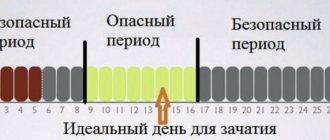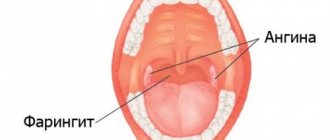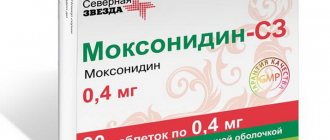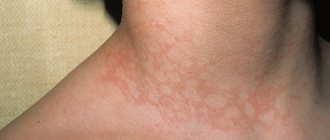Aug 28, 2007
Currently, the role of arterial hypertension (AH) in the development of atherosclerosis and systemic damage to peripheral arteries of target organs (heart, brain and kidneys) is generally recognized. The higher the blood pressure (BP), the greater the risk of developing cerebral stroke, coronary heart disease and sudden death. There is a positive correlation between the blood pressure value and the overall mortality rate: with an increase in systolic blood pressure by 10 mm Hg. Art. the risk of developing cardiovascular accidents increases by 10%. Calcium antagonists (ACa++) are first-line drugs in the treatment of hypertension, and the main place in this pharmacological group belongs to dihydropyridine derivatives. Although the use of short-acting ACa++ is still the subject of scientific debate, given the high bioavailability, the use of drugs in this group is justified. This statement is supported by the results of a clinical study of the use of ACa++ short-acting dihydropyridine series PHARMADIPINE, conducted under the leadership of Anastasia Galitskaya, senior researcher at the Institute of Cardiology. N. D. Strazhesko AMS of Ukraine.
Anastasia Galitskaya, Candidate of Medical Sciences, senior researcher at the Department of Clinical Rheumatology, Research Institute of Cardiology named after. N. D. Strazhesko AMS of Ukraine
— The drug PHARMADIPINE was developed at our institute by Professor A.P. Viktorov, produced by Farmak OJSC and is a 2% solution of nifedipine for oral use.
The issue of a therapeutic niche for the use of nifedipine solution was discussed at the level of the institute's management; a clinical trial protocol was developed, according to which patients were prescribed PHARMADIPINE in a low dose - 5-7 drops. Blood pressure levels were recorded at the 5th minute after taking the drug, then every 10 minutes for the 1st hour and every half hour for the 2nd and 3rd hours.
Typically, clinical trials are limited to small numbers of participants—about 30 patients per clinical unit. In this case, to achieve the most objective assessment, test protocols were distributed to almost all clinical departments of the institute - chronic ischemic heart disease, myocardial diseases and heart defects, symptomatic hypertension, essential hypertension, myocardial infarction and rehabilitation treatment, as well as to the arrhythmia department. The study also included patients from the institute’s clinic, where a team of cardiologists sees patients daily.
If a patient undergoing inpatient treatment or an outpatient developed a hypertensive crisis, he was prescribed PHARMADIPINE and blood pressure was recorded according to the above scheme (in the hospital the patient was under the supervision of the attending physician, in the clinic he was observed for 3-4 hours).
The effectiveness of PHARMADIPINE in relieving a hypertensive crisis has been proven in large-scale clinical studies, in which 226 patients were examined according to the protocol.
Let's compare: for a dissertation work it is necessary to analyze 80-100 clinical cases, thus the reliability of the results of this study is very high. At the end of the test, all protocols were collected, the data were brought together and their statistical analysis was carried out with the compilation of correlation graphs and tables.
Then, to conduct a study according to the extended protocol, a group of 45 patients who received basic complex antihypertensive therapy was formed. In the case of a hypertensive crisis, 24-hour Holter monitoring of blood pressure and ECG was carried out, a general blood and urine test, ECG and echoCG studies were performed before and after (after 3 days) taking PHARMADIPINE. After statistical processing of the data, the time of onset and duration of the hypotensive effect of the drug reliably coincided with the results of the previous trial and it was proven that taking PHARMADIPINE does not affect biochemical and general clinical parameters.
A statistically significant antihypertensive effect develops in the 8-10th minute after taking PHARMADIPINE, the maximum - in the 30-40th minute and lasts for 3-4 hours.
The drug cannot be prescribed routinely. We proceeded and continue to believe that short-acting ACa++ should be used once and only when indicated (like nitroglycerin during an angina attack). Having stopped the crisis, planned therapy should be immediately prescribed using angiotensin-converting enzyme inhibitors, long-acting ACa++, thiazide diuretics, b-adrenergic receptor blockers, etc.
If the rapid but short-term hypotensive effect of PHARMADIPINE is not “fixed in time,” a lasting effect will not be achieved, the crisis may develop again and the patient’s condition will worsen. It should be remembered that sudden changes in blood pressure levels - especially in older patients and with concomitant pathology - significantly increase the risk of developing cardiovascular accidents.
Based on the results of the study, changes were made to the instructions for use of PHARMADIPINE: in the original annotation the initial dose of use was indicated - 20 drops, but when using this regimen, collapse may occur (especially often in elderly and senile people); It has now been established that the optimal dose of the drug is 5-7 drops, and for elderly patients 3-5 drops are sufficient.
Short-acting ACa++ PHARMADIPINE can be used not only in cardiology hospitals, but also in clinics and in a selected individual dose at home.
Clinical recommendations for the use of PHARMADIPINE emphasize that this drug must be provided to the emergency medical service. PHARMADIPINE has a number of advantages that make it unsurpassed for urgent relief of high blood pressure: rapid antihypertensive effect (5-10 minutes), simplicity and accuracy of dosing (1 drop of solution contains 1 mg of nifedipine), ease of use (a few drops orally in a small amount of water or, even better, sublingually on a piece of sugar), economic availability (1 bottle of 25 ml - about 3.5 UAH).
And the main competitive advantage of PHARMADIPINE is that there is no other liquid dosage form of nifedipine (neither domestic nor foreign production) for urgent relief of hypertensive crisis on the Ukrainian pharmaceutical market.
Clinical recommendations prepared on the basis of the indicated advantages of the drug were included in the curriculum of cardiology schools, held quarterly by the institute in one of the regional centers of Ukraine. During their implementation, cardiologists were recommended to use in clinical practice an effective antihypertensive (and promising in terms of studying the antianginal effect) fast-acting ACa++ - the domestic drug PHARMADIPIN.
Photo by Evgeniy Krivsha
Share Tweet
Back to Farmak in the media Previous Next
Pharmacodynamics and pharmacokinetics
The drug blocks the flow of calcium ions to cardiomycytes and cells of the coronary and peripheral arteries through calcium channels of cell membranes, thus reducing blood pressure. The active substance nifedipine relaxes the smooth muscles of blood vessels along the periphery, eliminates spasms, dilates the coronary arteries , and the myocardial oxygen demand decreases. The drug also slightly reduces myocardial and the process of platelet aggregation .
Drops for oral administration are well and quickly absorbed from the gastrointestinal tract, their bioavailability is about 50%. When sublingually , the effect of the medicine occurs within 5-10 minutes.
The drug reaches its maximum effect 30-40 minutes after administration. Duration of action is up to 6 hours. About 90% of nifedipine is bound to plasma .
The drug undergoes metabolic in the liver tissues and is excreted in the form of metabolites after 2-4 hours.
In elderly people and people with liver diseases ( cirrhosis ), the half-life increases, almost 2 times, therefore, for this group of patients, adjustment of the dosage and dosage regimen is required. Nifedipine does not accumulate in the body. In small quantities, the drug passes into breast milk, through the placental and blood-brain barrier .
Farmadipin 2% 25 ml drops for oral administration
Instructions for medical use of the drug FARMADIPINE Trade name Farmadipine International nonproprietary name Nifedipine Dosage form Drops for oral use 2% Composition 1 ml of solution contains the active substance - nifedipine in terms of 100% substance - 20 mg, excipients: macrogol 400 - 0.8 ml, ethanol (96%) up to 1 ml Description Transparent yellow or greenish-yellow viscous liquid with a faint alcohol odor Pharmacotherapeutic group Selective blockers of “slow” calcium channels. Dihydropyridine derivatives. ATC code C08C A05 Pharmacological properties Pharmacokinetics When taken orally, it is well absorbed in the digestive tract, bioavailability is 40-60%. The effect develops especially quickly (within 5-10 minutes) when taken sublingually. Typically, the maximum effect is recorded after 30-40 minutes. Food intake does not significantly affect the rate of absorption of the drug. The hemodynamic effect lasts for 4-6 hours. Up to 90% of nifedipine is bound to plasma proteins. Metabolized in the liver and excreted from the body mainly in the form of inactive metabolites. The total clearance of nifedipine is from 0.4 to 0.6 l/kg/h. The half-life is 2-4 hours. In elderly people and patients with liver cirrhosis, the metabolism of nifedipine slows down, so their half-life of the drug can be extended by almost 2 times, which requires a dose reduction and an increase in the intervals between doses of the drug. Nifedipine does not accumulate in the body. In small quantities it penetrates the blood-brain and placental barriers and is excreted in breast milk. Pharmacodynamics Farmadipine exhibits antianginal and antihypertensive effects. Blocks the entry of calcium ions into cardiomyocytes and smooth muscle cells of coronary and peripheral arteries through slow voltage-dependent calcium channels of cell membranes. Relaxes vascular smooth muscles, eliminates spasms and dilates coronary and peripheral arteries, reducing peripheral vascular resistance, blood pressure, afterload and myocardial oxygen demand; slightly reduces myocardial contractility, slightly reduces platelet aggregation. Indications for use - arterial hypertension (for the treatment of hypertensive crises) Method of administration and dosage In case of a sudden increase in blood pressure (BP 180/100 mm Hg - 190/110 mm Hg), the initial single dose for adults is 3-5 drops (2 mg – 3.35 mg), for elderly and senile people – no more than 3 drops (2 mg) under the tongue or drop onto a piece of cracker or sugar, holding it in the mouth for as long as possible. If effectiveness is insufficient, the dose can be gradually increased to a clinically significant effect. In the future, in cases of increased blood pressure, it is necessary to focus on this dose. If necessary (increase in blood pressure to 190/100 mm Hg - 220/110 mm Hg), the single dose can be gradually increased in some cases to 10-15 drops (6.7 mg -10 mg), taking into account individual changes the patient's blood pressure indicators. The maximum single dose is 10 mg (15 drops). The maximum daily dose is 15-30 mg (21 drops-45 drops). Side effects - nausea - tachycardia - arterial hypotension - chest pain - "flushes" of blood to the face and upper body - swelling of the legs - weakness, dizziness, headache, drowsiness Rarely - allergic reactions in the form of skin rashes - parasthesia - depression - tremor fingers - increased daily diuresis - blurred vision - gum hyperplasia (with long-term use) Contraindications - allergic reaction to the components of the drug - cardiogenic shock, acute myocardial infarction, unstable angina, tachycardia - severe aortic and mitral stenosis - arterial hypotension - severe heart failure - weakness of the sinus node - porphyria - pregnancy and lactation - children under 18 years of age Drug interactions The hypotensive effect of Farmadipin is enhanced by drugs from the group of β-blockers, nitrates, diuretics, other antihypertensive drugs, tricyclic antidepressants, alcohol-containing drugs and drinks. In some cases, nifedipine causes a decrease in the concentration of quinidine in the blood plasma, and its withdrawal causes a significant increase in it. Based on this, when carrying out combination therapy, it is recommended to monitor the concentration of quinidine in the blood plasma. Diltiazem reduces the clearance of Farmadipine. Fentanyl significantly enhances the hypotensive effect, so taking Farmadipin should be stopped at least 36 hours before fentanyl is administered. When beta-blockers are used together with Farmadipin, the development of arterial hypotension and heart failure (especially with propranolol) is possible. Farmadipine increases the concentration of digoxin, carbamazepine and theophylline in the blood. Cimetidine increases the concentration of Farmadipine in the blood plasma. Rifampicin weakens the therapeutic effect of Farmadipin by accelerating its metabolism. Special instructions It is necessary to take into account the individual sensitivity of individual patients to Farmadipin. In such cases, the dose is selected individually, starting with three drops and gradually increasing by 2-3 drops (1.34 mg - 2 mg) until a clinical effect is achieved. Exceeding the initial dose of the drug can lead to a sharp decrease in blood pressure! Features of the effect of the drug on the ability to drive a vehicle or potentially dangerous mechanisms The drug can affect the psychophysical state of patients, which is manifested by weakening of attention, slower reactions, and requires caution when driving vehicles and working with potentially dangerous mechanisms. Overdose Symptoms: sharp decrease in blood pressure, heart failure, shock, metabolic acidosis and convulsions. Treatment: gastric lavage, intake of activated carbon, administration of sympathomimetics, calcium chloride, symptomatic therapy. Release form and packaging Drops for oral use 2%. 5 ml or 25 ml in glass bottles, enclosed with instructions for medical use in a cardboard box. Storage conditions Store in a dry place, protected from light and out of reach of children, at a temperature of 15 ºС to 25 ºС. Keep out of the reach of children! Shelf life: 3 years The drug should not be used after the expiration date indicated on the package. Conditions for dispensing from pharmacies By prescription Manufacturer OJSC “Farmak” Address: Ukraine, 04080, Kiev, st. Frunze, 63.
Contraindications
Framadipine drops should not be used:
- if allergic to the active substance or auxiliary components;
- pregnant (up to 20 weeks) and lactating women;
- for aortic stenosis , myocardial infarction , unstable angina ;
- patients with ileostomy or colostomy ;
- with cardiogenic shock ;
- in combination with rifampicin .
Side effects
Possible adverse reactions from taking Farmadipin:
- anxiety, insomnia ;
- hyperglycemia;
- agranulocytosis , leukopenia ;
- nosebleeds, dyspnea , nasal congestion;
- tachycardia , angina pectoris ;
- edema , angioedema , urticaria , rashes, anaphylactic reactions ;
- polyuria , dysuria ;
- headache , vertigo , tremor , migraine , drowsiness , hypersthesia , paresthesia , dysesthesia ;
- impaired visual acuity, painful sensations in the eyes;
- convulsions , joint swelling, myalgia , arthralgia ;
- decreased blood pressure , loss of consciousness, vasodilation ;
- constipation , pain in the epigastric region, nausea, flatulence , dry mucous membranes, dysphagia ;
- jaundice , increased activity enzymes ;
- intestinal obstruction, intestinal ulcer , vomiting, gingival hyperplasia , bezoar ;
- fever;
- toxic epidermal necrolysis , purpura , light sensitivity, erythema ;
- decreased libido , erectile dysfunction .
PHARMADIPINE DROPS 2% 25ML
Instructions
Trade name of the drug: Farmadipin®
Active ingredient (INN): nifedipine (nifedipine)
Dosage form: oral drops
Compound:
1 ml of solution contains: active substance: nifedipine in terms of 100% dry substance 20 mg (30 drops); excipients: polyethylene glycol 400, ethanol 96%.
Description: transparent yellow or greenish-yellow viscous liquid with a faint alcoholic odor.
Pharmacotherapeutic group: selective calcium antagonists with a predominant effect on blood vessels.
Pharmacological properties Pharmacodynamics Farmadipin® exhibits antianginal and antihypertensive effects. Blocks the entry of calcium ions into cardiomyocytes and smooth muscle cells of coronary and peripheral arteries through slow voltage-dependent calcium channels of cell membranes. Relaxes vascular smooth muscles, eliminates spasms and dilates coronary and peripheral arteries, reducing peripheral vascular resistance, blood pressure, afterload and myocardial oxygen demand; slightly reduces myocardial contractility, slightly reduces platelet aggregation.
Pharmacokinetics
When taken orally, it is well absorbed from the digestive tract, bioavailability is 40-60%. The effect develops especially quickly (within 5-10 minutes) when taken sublingually. Typically, the maximum effect is recorded after 30-40 minutes. Food intake does not significantly affect the rate of absorption of the drug. The hemodynamic effect lasts for 4-6 hours. Up to 90% of nifedipine is bound to plasma proteins. Metabolized in the liver and excreted from the body mainly in the form of inactive metabolites. The total clearance of nifedipine is from 0.4 to 0.6 l/kg/h. The half-life is 2-4 hours. In elderly people and patients with liver cirrhosis, the metabolism of nifedipine slows down, so their half-life of the drug can be extended by almost 2 times, which requires a dose reduction and an increase in the intervals between doses of the drug. Nifedipine does not accumulate in the body. In small quantities it penetrates the blood-brain and placental barriers and passes into breast milk.
Indications for use
Arterial hypertension (for the purpose of treating hypertensive crises).
Directions for use and doses
Farmadipin® is used for the treatment of hypertensive crisis as an emergency drug. It is not recommended to use the drug in this dosage form for a course of treatment. If it is necessary to carry out a course of antihypertensive therapy, the drug and dosage form are selected by the doctor. In case of a sudden and significant increase in blood pressure, the initial single dose for adults is 3-5 drops (2-3.35 mg), for elderly people - no more than 3 drops (2 mg) under the tongue or drop onto a piece of cracker or sugar, as hold it in your mouth for as long as possible. If effectiveness is insufficient, the dose can be gradually increased to a clinically significant effect. In the future, in cases of increased blood pressure, it is necessary to focus on this dose. If necessary (increase in blood pressure to 190/100 mm Hg - 220/110 mm Hg), the single dose can be gradually increased in some cases to 10-15 drops (6.7-10 mg), taking into account individual changes in indicators The patient's blood pressure. It is necessary to take into account the individual sensitivity of individual patients to Farmadipin®. In such cases, the dose should be selected individually, starting with 3 drops, and gradually increased by 2-3 drops (1.34-2 mg) until a clinical effect is achieved. Exceeding the initial dose of the drug can lead to a sharp decrease in blood pressure!
Side effects
From the blood and lymphatic system: leukopenia, agranulocytosis. From the immune system: allergic reactions, allergic edema/angioedema (including laryngeal edema*), itching, urticaria, rash, anaphylactic/anaphylactoid reaction. Mental disorders: anxiety reactions, sleep disorders. From the nervous system: headache, vertigo, migraine, dizziness, tremor, hypoesthesia, paresthesia, dysesthesia, drowsiness. From the side of metabolism and metabolism: hyperglycemia. From the organs of vision: visual disturbances, pain in the eyes. From the heart system: tachycardia, increased heartbeat, chest pain (angina). Vascular disorders: edema, vasodilation, hypotension, loss of consciousness. From the respiratory system: nosebleeds, nasal congestion, dyspnea. From the gastrointestinal tract: constipation, pain in the gastrointestinal tract and abdominal pain, nausea, dyspepsia, flatulence, dry mouth, gingival hyperplasia, bezoar, dysphagia, intestinal obstruction, intestinal ulcer, vomiting, gastroesophageal sphincter insufficiency. From the liver and biliary tract: transient increase in the activity of liver enzymes, jaundice. From the skin and subcutaneous tissue: erythema, toxic epidermal necrolysis, photosensitivity, purpura. From the musculoskeletal system, connective tissue and bones: muscle cramps, joint swelling, arthralgia, myalgia. From the kidneys and urinary tract: polyuria, dysuria. From the reproductive system and mammary glands: erectile dysfunction. General disorders: feeling of malaise, nonspecific pain, fever. *may lead to life-threatening consequences. Patients with malignant hypertension and hypovolemia who are on hemodialysis may experience a significant decrease in blood pressure due to vasodilation.
Contraindications
The use of the drug is contraindicated in cases of known individual hypersensitivity to nifedipine and excipients, women during pregnancy (up to 20 weeks) and lactation, with cardiogenic shock, in combination with rifampicin (due to the inability to achieve effective levels of nifedipine in plasma due to enzyme induction ), with high-grade aortic stenosis, unstable angina, acute myocardial infarction (within the first 4 weeks), ileostomy or colostomy.
Drug interactions
Drugs that affect the effectiveness of nifedipine. Nifedipine is metabolized through the cytochrome P450 3A4 system, which is located in the intestinal mucosa and liver. Therefore, drugs that inhibit or induce this enzyme system may alter the first pass (after oral administration) or clearance of nifedipine. When using nifedipine together with the following drugs, the degree and duration of interaction should be taken into account. Rifampicin Rifampicin significantly induces the cytochrome P450 3A4 system. When used concomitantly with rifampicin, the bioavailability of nifedipine is significantly reduced and, thus, its effectiveness is weakened. Given this, the use of a combination of nifedipine and rifampicin is contraindicated. When using the following weak or moderate inhibitors of the cytochrome P450 3A4 system simultaneously, it is necessary to monitor blood pressure and, if necessary, consider reducing the dose of nifedipine. Macrolide antibiotics (eg, erythromycin) Interaction studies between nifedipine and macrolide antibiotics have not been conducted. Certain macrolide antibiotics inhibit the cytochrome P450 3A4 system-mediated metabolism of other drugs. Taking this into account, the possibility of an increase in plasma concentrations of nifedipine cannot be excluded when both drugs are used simultaneously. Azithromycin, which is structurally similar to members of the macrolide class of antibiotics, does not inhibit CYP3A4. Anti-HIV protease inhibitors (eg, ritonavir) A clinical study examining the potential for interactions between nifedipine and certain anti-HIV protease inhibitors has not yet been conducted. It is known that drugs of this class inhibit the cytochrome P450 3A4 system. In addition, drugs of this class inhibit in vitro the metabolism of nifedipine mediated by the cytochrome P450 3A4 system. When used simultaneously with nifedipine, a significant increase in the plasma concentration of nifedipine cannot be ruled out due to a decrease in first-pass metabolism and a decrease in the rate of excretion from the body. Azole antimycotics (eg, ketoconazole) A clinical study examining the potential for interactions between nifedipine and certain azole antimycotics has not yet been conducted. It is known that drugs of this class inhibit the cytochrome P450 3A4 system. When administered orally concomitantly with nifedipine, a significant increase in the systemic bioavailability of nifedipine due to a decrease in first-pass metabolism cannot be ruled out. Fluoxetine A clinical study examining the potential for interactions between nifedipine and fluoxetine has not yet been conducted. Fluoxetine is known to inhibit the cytochrome P450 3A4 system-mediated metabolism of nifedipine in vitro. With the simultaneous use of both drugs, an increase in the concentration of nifedipine in plasma cannot be excluded.
Nefazodone A clinical study examining the potential for interaction between nifedipine and nefazodone has not yet been conducted. Nefazodone is known to inhibit the in vitro cytochrome P450 3A4 system-mediated metabolism of other drugs. With the simultaneous use of both drugs, an increase in the concentration of nifedipine in plasma cannot be excluded. Quinupristin/dalfopristin Concomitant use of quinupristin/dalfopristin and nifedipine may lead to increased plasma concentrations of nifedipine. Valproic acid A clinical study examining the potential for interactions between nifedipine and valproic acid has not yet been conducted. Valproic acid is known to increase plasma concentrations of the structurally similar calcium channel blocker nimodipine due to enzyme inhibition. Taking this into account, an increase in plasma concentrations of nifedipine and an increase in effectiveness cannot be ruled out. Cimetidine Due to the inhibition of cytochrome P450 3A4, cimetidine increases plasma concentrations of nifedipine and may enhance the antihypertensive effect.
Instructions for use of Farmadipin (method and dosage)
The medicine is used in emergency cases to treat hypertensive crises . Taking the drug in courses is highly not recommended.
With a sharp and significant increase in blood pressure , it is recommended to take 3-5 drops sublingually (2-3 mg). The maximum single dosage for elderly patients is 3 drops.
The drops can be applied to a piece of sugar or bread and allowed to remain in the victim’s mouth for as long as possible.
If the standard dosage turns out to be ineffective, the dose can be gradually increased until the effect is achieved. The next time during a hypertensive crisis, it is recommended to use the same dosage.
The maximum amount of the drug that can be given to the patient at a time is 10-15 drops (up to 10 mg).
Please be aware that some people may have a severe reaction to the medicine. Therefore, it is recommended to start with 3 drops, then gradually increase the dosage to the maximum. Failure to comply with this rule can lead to a sharp decrease in blood pressure .
Use of the drug Farmadipin
Farmadipine is prescribed sublingually. In case of a sudden increase in blood pressure (180/100–190/110 mm Hg), the initial single dose of the drug in adults is 3–5 drops (2–3.35 mg), in elderly and senile people - no more than 3 drops ( 2 mg) under the tongue (you can drop Farmadipin onto a piece of sugar or cracker and ask the patient to hold it in the mouth for as long as possible). If effectiveness is insufficient, the dose of the drug is gradually increased to clinically effective. In the future, when blood pressure increases, it is necessary to focus on this dose. If necessary (increase in blood pressure to 190/100–220/110 mm Hg), the single dose of the drug can be gradually increased to 10–15 drops (6.7–10 mg), taking into account changes in blood pressure in a particular patient. It is necessary to take into account the increased sensitivity of individual patients to Farmadipine. In these cases, the dose is selected individually, starting with 3 drops and gradually increasing it by 2-3 drops (1.34-2 mg) until the required clinical effect is achieved. Exceeding the initial dose of the drug can lead to a sharp decrease in blood pressure!
Overdose
In case of an overdose of the drug, the following occurs: decreased blood pressure , tachycardia , bradycardia , hypoxia , metabolic acidosis , impaired consciousness, even coma , pulmonary edema .
To eliminate the unwanted symptoms of an overdose, it is necessary to remove the drug from the body as soon as possible and stabilize the patient’s condition, primarily blood pressure and other hemodynamic parameters.
After oral administration, it is recommended to perform gastric lavage and, if necessary, rinse the small intestine.
Hemodialysis is ineffective; plasmapheresis . beta-sympathomimetics , calcium preparations (10-20 ml of calcium chloride or calcium gluconate intravenously), dopamine , norepinephrine is also indicated , and if life is threatened, installation of an artificial pacemaker . Caution should be exercised when introducing any liquid into the body, as this increases the load on the heart muscle.
Farmadipin oral drops for high blood pressure 2%, 25 ml
Drugs that affect the effectiveness of nifedipine
Nifedipine is metabolized through the cytochrome P450 3A4 system, which is located in the intestinal mucosa and liver. Therefore, drugs that inhibit or induce this enzyme system may alter the first pass (after oral administration) or clearance of nifedipine.
When using nifedipine together with the following drugs, the degree and duration of interaction should be taken into account.
Rifampicin
Rifampin significantly induces the cytochrome P450 3A4 system. When used concomitantly with rifampicin, the bioavailability of nifedipine is significantly reduced and, thus, its effectiveness is weakened. Given this, the use of a combination of nifedipine and rifampicin is contraindicated.
When using the following weak or moderate inhibitors of the cytochrome P450 3A4 system simultaneously, it is necessary to monitor blood pressure and, if necessary, consider reducing the dose of nifedipine.
Macrolide antibiotics (eg, erythromycin)
Interaction studies between nifedipine and macrolide antibiotics have not been conducted. Certain macrolide antibiotics inhibit the cytochrome P450 3A4 system-mediated metabolism of other drugs. Taking this into account, the possibility of an increase in plasma concentrations of nifedipine cannot be excluded when both drugs are used simultaneously.
Azithromycin, which is structurally similar to members of the macrolide class of antibiotics, does not inhibit CYP3A4.
Anti-HIV protease inhibitors (eg, ritonavir)
A clinical study examining the potential for interactions between nifedipine and certain anti-HIV protease inhibitors has not yet been conducted. It is known that drugs of this class inhibit the cytochrome P450 3A4 system. In addition, drugs of this class inhibit in vitro the metabolism of nifedipine mediated by the cytochrome P450 3A4 system. When used simultaneously with nifedipine, a significant increase in the plasma concentration of nifedipine cannot be ruled out due to a decrease in first-pass metabolism and a decrease in the rate of excretion from the body.
Azole antimycotics (eg, ketoconazole)
A clinical study examining the potential for interactions between nifedipine and certain azole antimycotics has not yet been conducted. It is known that drugs of this class inhibit the cytochrome P450 3A4 system. When administered orally concomitantly with nifedipine, a significant increase in the systemic bioavailability of nifedipine due to a decrease in first-pass metabolism cannot be ruled out.
Fluoxetine
A clinical study examining the potential for interaction between nifedipine and fluoxetine has not yet been conducted. Fluoxetine is known to inhibit the cytochrome P450 3A4 system-mediated metabolism of nifedipine in vitro. With the simultaneous use of both drugs, an increase in the concentration of nifedipine in plasma cannot be excluded.
Nefazodone
A clinical study examining the potential for interaction between nifedipine and nefazodone has not yet been conducted. Nefazodone is known to inhibit the in vitro cytochrome P450 3A4 system-mediated metabolism of other drugs. With the simultaneous use of both drugs, an increase in the concentration of nifedipine in plasma cannot be excluded.
Quinupristin/dalfopristin
Concomitant use of quinupristin/dalfopristin and nifedipine may lead to increased plasma concentrations of nifedipine.
Valproic acid
A clinical study examining the potential for interactions between nifedipine and valproic acid has not yet been conducted. Valproic acid is known to increase plasma concentrations of the structurally similar calcium channel blocker nimodipine due to enzyme inhibition. Taking this into account, an increase in plasma concentrations of nifedipine and an increase in effectiveness cannot be ruled out.
Cimetidine
Due to inhibition of cytochrome P450 3A4, cimetidine increases plasma concentrations of nifedipine and may enhance the antihypertensive effect.
Cisapride
Concomitant use of cisapride and nifedipine may lead to increased plasma concentrations of nifedipine.
Antiepileptic drugs that induce the cytochrome P450 3A4 system, such as phenytoin, carbamazepine and phenobarbital
Phenytoin induces the cytochrome P450 3A4 system. When used simultaneously with phenytoin, the bioavailability of nifedipine is reduced and the effectiveness is weakened. When using both drugs simultaneously, it is necessary to monitor the clinical response to nifedipine therapy and, if necessary, consider increasing the dose of nifedipine. If the dose of nifedipine is increased during simultaneous use of both drugs, a reduction in the dose of nifedipine should be considered when discontinuing phenytoin.
Clinical studies have not been conducted to examine the likelihood of a potential interaction between nifedipine and carbamazepine or phenobarbital. Both drugs are known to reduce plasma concentrations of the structurally similar calcium channel blocker nimodipine due to enzyme induction. Taking this into account, a decrease in plasma concentrations of nifedipine and a decrease in effectiveness cannot be ruled out.
Antihypertensive drugs
Nifedipine can increase the antihypertensive effect of antihypertensive drugs that are used simultaneously, such as: diuretics, β-blockers, ACE inhibitors, AT1 receptor antagonists, other calcium antagonists, α-adrenergic blockers, PDE5 inhibitors, α-methyldopa, magnesium sulfate.
When nifedipine is used concomitantly with beta-blockers, careful monitoring of the patient is necessary, since isolated cases of exacerbation of heart failure are known.
Digoxin and theophylline
The combination of nifedipine with digoxin and theophylline is usually well tolerated by patients; very rarely, an increase in the level of digoxin and theophylline in the blood plasma is possible (the content of the latter in the blood plasma should be monitored). With simultaneous use of nifedipine and digoxin, the clearance of digoxin may decrease and the concentration of digoxin in plasma may increase. Given this, the patient should be monitored for symptoms of digoxin overdose and, if necessary, the dose of the glycoside should be reduced, taking into account the concentration of digoxin in plasma.
Amiodarone and quinidine
Amiodarone and quinidine may enhance the negative inotropic effect of nifedipine. With the simultaneous use of nifedipine and quinidine, in some cases a decrease in the level of quinidine was observed, and when nifedipine was discontinued, a sharp increase in the concentration of quinidine in plasma was observed. Given this, when using or discontinuing nifedipine simultaneously, it is recommended to monitor plasma quinidine concentrations and, if necessary, adjust the quinidine dose. Some authors have reported an increase in plasma concentrations of nifedipine with simultaneous use of both drugs, but other authors have not noted changes in the pharmacokinetics of nifedipine.
Given this, blood pressure should be carefully monitored when quinidine is included in a nifedipine therapy regimen. If necessary, the dose of nifedipine should be reduced.
Tacrolimus
Tacrolimus is known to be metabolized through the cytochrome P450 3A4 system. Published data indicate that in selected cases the dose of tacrolimus may be reduced when used concomitantly with nifedipine. When both drugs are used concomitantly, tacrolimus plasma concentrations should be monitored and a dose reduction of tacrolimus should be considered if necessary.
Other types of interactions
Grapefruit juice
Grapefruit juice inhibits the cytochrome P450 3A4 system. Drinking grapefruit juice while using nifedipine leads to an increase in plasma concentrations of the drug and an increase in the duration of action of nifedipine due to a decrease in first-pass metabolism or decreased clearance. As a result, the antihypertensive effect of the drug may be enhanced. After drinking grapefruit juice regularly, this effect may last for at least 3 days after the last time you consumed the juice.
Given this, grapefruit/grapefruit juice should be avoided during nifedipine therapy.
The use of nifedipine may lead to falsely elevated results when spectrophotometrically determining the concentration of vanillylmandelic acid in urine (however, this effect is not observed when using the high-performance liquid chromatography method).
Interaction
When taking Digoxin and Farmadipin in combination, the clearance of Digoxin decreases, and its concentration in the blood plasma increases.
The product can be combined with Azithromycin .
The metabolism of the drug is carried out with the participation of the cytochrome P450 3A4 , therefore, when combining nifedipine with drugs that affect the functioning of this system, caution should be exercised.
When combined with Rifampicin, the bioavailability of the drug is significantly reduced, and the effectiveness of Pharmadipine decreases.
Due to the inhibition the cytochrome P450 system by cimetidine , the effectiveness of the drops, their antihypertensive effect and concentration in the blood can significantly increase.
Azole antifungals ( Ketoconazole, Voriconazole, Fluconazole, Intraconazole ) inhibit the cytochrome P450 3A4 and, when combined with Farmadipin drops, an increase in their bioavailability cannot be ruled out due to a decrease in first-pass metabolism.
Despite the fact that no studies have been conducted on the interaction of macrolide antibiotics with the drug, it is known that antibiotics inhibit the metabolism of drugs, the process of absorption of which occurs with the participation of P450 3A4 . Therefore, when combining the drug with this group of drugs (for example, Erythromycin ), caution should be exercised.
In vitro studies have shown that anti-HIV protease inhibitors ( Ritonavir ) reduce the effectiveness of nifedipine. As a result, the concentration of the active substance in the blood plasma can increase significantly, and the drug will be eliminated from the body more slowly.
Fluoxetine, Nefazodone, cisapride, Quinupristin, Valproic acid can lead to an increase in the amount of Farmadipine in the blood.
When the drug is combined with antihypertensive drugs , diuretics , ACE , beta blockers , calcium antagonists , alpha adrenergic blockers , methyldopa , magnesium sulfate , their effectiveness increases; dosage adjustment is required.
Antiepileptic drugs , Carbamazepine , Phenobarbital reduce the plasma concentration and effectiveness of phenytoin . Therefore, it is recommended to increase its dosage. When discontinuing one of the medications, the dosage of the drug should, on the contrary, be reduced.
When the drug was combined with Quinidine, a decrease in the level of the antiarrhythmic drug in the blood was observed. After discontinuation of the drops, the concentration of Quinidine in plasma increased sharply. With this combination, it is recommended to monitor blood pressure and drug concentrations.
Tacrolimus with caution (its dosage may need to be reduced).
Grapefruit juice can reduce the clearance of the drug, increase its content in the blood, and increase the duration of its action. The effect lasts for 3 days after drinking the juice. During nifedipine therapy, it is not recommended to eat grapefruits or drink drinks with grapefruit juice.
Drug interactions Farmadipin
The hypotensive effect of Farmadipin is enhanced by drugs from the group of β-adrenergic receptor blockers, nitrates, diuretics, other antihypertensive drugs, tricyclic antidepressants, drugs and drinks containing alcohol. In some cases, nifedipine reduces the concentration of quinidine in the blood plasma, and its withdrawal significantly increases it. Based on this, when carrying out combination therapy, it is recommended to monitor the concentration of quinidine in the blood plasma. Diltiazem reduces the clearance of Farmadipine. Fentanyl significantly enhances the hypotensive effect, so taking Farmadipin should be stopped at least 36 hours before fentanyl is administered. When beta-blockers are used together with Farmadipin, hypotension may develop. Farmadipine increases the concentration of digoxin, carbamazepine and theophylline in the blood. Cimetidine increases the concentration of Farmadipine in the blood plasma. Rifampicin weakens the therapeutic effect of Farmadipin by accelerating its metabolism.
special instructions
It should be remembered that the medicine should not be given to patients with an ileostomy .
After taking the medicine, you cannot take x-rays of the gastrointestinal tract using barium contrast agent . These studies may be false positive.
For patients with severely low blood pressure (below 90 mmHg) or for heart failure, the drug is recommended to be used with extreme caution.
If the patient has severe narrowing in the gastrointestinal tract , this can lead to the development of obstructive symptoms. Bezoars , which require surgery, are very rare to form.
In case of severe liver diseases, it is necessary to adjust the dosage of the drug and closely monitor the functioning of the liver.
Experiments conducted in vitro showed that the drug affects sperm and quality.
ischemic heart pain or angina pectoris developed during the previous dose .
With extreme caution, the drug is prescribed to patients who are on hemodialysis , in the presence of hypovolemia or low blood pressure .
Patients with diabetes insulin dosage adjustment .
At the initial stages of treatment with the drug, it is recommended to refrain from driving.
Description
Farmadipine is an antianginal and antihypertensive drug.
Blocks the entry of calcium ions into cardiomyocytes and smooth muscle cells of coronary and peripheral arteries through slow voltage-dependent calcium channels of cell membranes. Relaxes vascular smooth muscles, eliminates spasms and dilates coronary and peripheral arteries, reducing peripheral vascular resistance, blood pressure, afterload and myocardial oxygen demand; slightly reduces myocardial contractility, slightly reduces platelet aggregation. Pharmacokinetics
When taken orally, it is well absorbed from the digestive tract, bioavailability is 40-60%. The effect develops especially quickly (within 5-10 minutes) when taken sublingually. Typically, the maximum effect is recorded after 30-40 minutes. Food intake does not significantly affect the rate of absorption of the drug. The hemodynamic effect lasts for 4-6 hours. Up to 90% of nifedipine is bound to plasma proteins. Metabolized in the liver and excreted from the body mainly in the form of inactive metabolites. The total clearance of nifedipine is from 0.4 to 0.6 l/kg/h. The half-life is 2-4 hours. In elderly people and patients with liver cirrhosis, the metabolism of nifedipine slows down, so their half-life of the drug can be extended by almost 2 times, which requires a dose reduction and an increase in the intervals between doses of the drug. Nifedipine does not accumulate in the body. In small quantities it penetrates the blood-brain and placental barriers and is excreted in breast milk. Indications for use
The drug Farmadipin is used for arterial hypertension (for the treatment of hypertensive crises). Mode of application
Farmadipine is used to treat hypertensive crisis as an emergency drug. It is not recommended to use the drug in this dosage form for a course of treatment. If a course of antihypertensive therapy is necessary, the doctor selects the drug and dosage form. In case of a sudden and significant increase in blood pressure, the initial single dose for adults is 3-5 drops (2-3.35 mg), for elderly people - no more than 3 drops (2 mg) under the tongue or drop onto a piece of cracker or sugar, as hold it in your mouth for as long as possible. If effectiveness is insufficient, the dose can be gradually increased to a clinically significant effect. In the future, in cases of increased blood pressure, it is necessary to focus on this dose. If necessary (increase in blood pressure to 190/100 mm Hg - 220/110 mm Hg), the single dose can be gradually increased in some cases to 10-15 drops (6.7-10 mg), taking into account individual changes in indicators The patient's blood pressure. It is necessary to take into account the individual sensitivity of individual patients to Farmadipin®. In such cases, the dose is selected individually, starting with three drops, and gradually increased by 2-3 drops (1.34-2 mg) until a clinical effect is achieved. Exceeding the initial dose of the drug can lead to a sharp decrease in blood pressure! Side effects
If you follow the recommendations for the use of the drug Farmadipin, side effects are minor and transient, as a rule, do not require discontinuation of therapy. With frequent and uncontrolled use, adverse reactions characteristic of drugs of this pharmacological group are possible. From the cardiovascular system: often - edema, vasodilation, infrequently - tachycardia, increased heart rate, arterial hypotension, syncope. From the central and peripheral nervous system: often – headache; uncommon – vertigo, migraine, dizziness, tremor, sleep disorder, anxiety; rarely - short-term visual impairment, agitation, paresthesia, dysesthesia. From the endocrine system: hyperglycemia (should be taken into account in patients with diabetes mellitus). From the digestive system: often – constipation; infrequently, when using higher doses, abdominal pain, dyspeptic symptoms, flatulence, nausea, vomiting (very rare), gingival hyperplasia (with long-term use), dry mouth, transient increase in liver enzymes occur. From the urinary system: infrequently – polyuria, dysuria. From the hematopoietic system: rarely – anemia, leukopenia, thrombocytopenia. Allergic reactions: uncommon - allergic reaction, allergic edema/angioedema (including laryngeal edema); rarely – itching, urticaria, rash; very rarely - anaphylactic/anaphylactoid reactions. Others: often - feeling unwell; infrequently - nosebleeds, nasal congestion, erythema; rarely - swelling of the lower leg, muscle cramps, swelling of the joints, erectile dysfunction, nonspecific pain, fever, dyspnea. Contraindications
Contraindications to the use of the drug Farmadipin are: acute myocardial infarction (first 4 weeks); cardiogenic shock; severe aortic and mitral stenosis; unstable angina; do not use for the treatment of angina attacks, secondary prevention of myocardial infarction; heart failure in the stage of decompensation; arterial hypotension (systolic blood pressure below 90 mmHg); ventricular tachycardia with widened QRS complex; sick sinus syndrome; Wolff-Parkinson-White syndrome (WPW), Lown-Genong-Levine syndrome (LGL); AV block II and III degrees; porphyria; ileostomy installed after proctocolectomy; pregnancy; breastfeeding period; childhood; hypersensitivity to nifedipine and other components of the drug; hypersensitivity to other dihydropyridines; Do not take simultaneously with rifampicin. Pregnancy
Farmadipine is contraindicated for use during pregnancy. Nifedipine passes into breast milk, so breastfeeding should be stopped while using the drug. Interaction with other drugs: Nifedipine may increase the antihypertensive effect of antihypertensive drugs that are used simultaneously, such as diuretics, beta-blockers, ACE inhibitors, AT-1 receptor antagonists, other calcium antagonists, α-adrenergic blockers, PDE5 inhibitors, α-methyldopa . When combined with beta-blockers, along with an increase in the hypotensive effect, in some cases the development of heart failure is possible. Diltiazem slows down the elimination of nifedipine from the body (if necessary, reduce the dose of nifedipine). Amiodarone and quinidine may enhance the negative inotropic effect of nifedipine. In some cases, when nifedipine and quinidine are combined when taken orally, the concentration of quinidine in the blood plasma decreases. Combinations of nifedipine with cardiac glycosides and theophylline are usually well tolerated by patients; in very rare cases, an increase in the level of digoxin and theophylline in the blood plasma is possible (the content of the latter in the blood plasma should be monitored). Nifedipine increases the concentration of carbamazepine and phenytoin in the blood serum. Concomitant use of nifedipine and cimetidine may lead to increased plasma levels of nifedipine. Rifampin induces the activity of liver enzymes, accelerating the metabolism of nifedipine, which may lead to a decrease in the clinical effect of nifedipine (this combination is contraindicated). Treatment with nifedipine should be discontinued 36 hours before planned anesthesia with fentanyl. Nifedipine is compatible with radiocontrast agents. Nifedipine in combination with intravenous magnesium sulfate in pregnant women can cause neuromuscular blockade. Nifedipine is metabolized through the cytochrome P450 3A4 system, located in the intestinal mucosa and liver. Therefore, drugs that inhibit or induce this enzyme system may alter the first-pass effect (following oral administration) or clearance of nifedipine. Concomitant use of macrolide antibiotics (eg, erythromycin), anti-HIV protease inhibitors (eg, ritonavir), azole antifungals (eg, ketaconazole), nefazodone, fluoxetine, quinupristin/dalfopristin, cimetidine, cisapride and nifedipine may lead to increased plasma concentrations of nifedipine . Valproic acid is known to increase plasma concentrations of the structurally similar calcium channel blocker nimodipine due to enzyme inhibition. Therefore, an increase in plasma concentrations of nifedipine and an increase in effectiveness cannot be excluded. Tacrolimus is known to be metabolized through the cytochrome P450 3A4 system. Published data indicate that in selected cases the dose of tacrolimus may be reduced when used concomitantly with nifedipine. When the two drugs are used concomitantly, tacrolimus plasma concentrations should be monitored and, if necessary, a dose reduction of tacrolimus should be considered. Grapefruit juice inhibits the cytochrome P450 3A4 system. Drinking grapefruit juice while using nifedipine leads to an increase in plasma concentrations of the drug and an increase in the duration of action of nifedipine due to a decrease in first-pass metabolism or decreased clearance. As a result, the antihypertensive effect of the drug may be enhanced. After drinking grapefruit juice regularly, this effect may last for 3 days after the last juice consumption. Therefore, grapefruits/grapefruit juice should be avoided during nifedipine therapy. The use of nifedipine may lead to false results when spectrophotometrically determining the concentration of vanillyl-mandelic acid in urine (this effect was not observed when using the high-performance liquid chromatography method). Overdose
Symptoms of acute intoxication with Farmadipin: impaired consciousness up to coma, decreased blood pressure, tachycardia/bradycardia, hyperglycemia, metabolic acidosis, hypoxia, cardiogenic shock, which is accompanied by pulmonary edema. Treatment. Emergency care measures should primarily be aimed at removing the drug from the body and restoring stable hemodynamics. After oral administration, it is recommended to completely empty the stomach, if necessary, in combination with small intestinal lavage. Since nifedipine is characterized by a high degree of binding to plasma proteins and a relatively low volume of distribution, hemodialysis is ineffective, but plasmapheresis is recommended. Bradycardia can be treated with beta sympathomimetics. When the heart rate slows down and is life-threatening, the use of an artificial pacemaker is recommended. Hypotension, which arose as a result of cardiogenic shock and vasodilation, can be removed with calcium preparations (10-20 ml of a 10% solution of calcium chloride or gluconate is administered intravenously slowly, then repeated if necessary). As a result, serum calcium levels may reach the upper limit of normal or be slightly elevated. If calcium administration is not effective enough, it is advisable to use sympathomimetics such as dopamine or norepinephrine. The doses of these drugs are selected taking into account the achieved therapeutic effect. Additional fluid administration should be approached very carefully, as this increases the risk of cardiac overload. Storage conditions
Store in a dry place, protected from light, at a temperature not exceeding 25 °C.
Keep out of the reach of children. Attention! The description of the drug on this page is simplified. Before purchasing and using the drug, consult your doctor or pharmacist, and also read the instructions approved by the manufacturer. Information about the drug is provided for informational purposes only and should not be used as a guide to self-medication. ATTENTION! This section is provided for informational purposes only and is not a catalog or price list of our company. To obtain information about the availability of drugs, call + 99871 202 0999 Pharmacy Network Helpline 999.
Analogs
Level 4 ATC code matches:
Lacipil
Cordafen
Azomex
Nimodipine
Felodipin
Nifedipine
Amlotop
Nimotop
Tenox
Nifecard HL
Cordipin
Felodip
Normodipine
Phenigidine
Norvask
Cordaflex
Lerkamen
Corinfar
Vero-Amlodipine
Amlodipine
Cordaflex, Lerkamen, Vero-Amlodipine, Amlodipine, Adalat, Cordipine, Corinfar, Nifedipine, Phenigidine, Emlodin, Amlotop, Nimotol, Tenox, Felodip, Tensigal, Tenox, Normodipine, Nemotan, Nifecard XL, Cordipine, Norvasc.
During pregnancy and lactation
Nifedinip should not be prescribed to women in the first trimester of pregnancy .
Animal studies have shown that the drug has low embryotoxicity and fetotoxicity . However, the question of taking the drug by pregnant women should be decided after consultation with the attending physician.
breastfeeding while the drug is working .
Reviews of Farmadipin drops
Reviews about the medicine are good. Drops quickly and effectively reduce high blood pressure, especially during a hypertensive crisis . Some people don’t really like the specific smell and taste of the product, and the fact that it is difficult to wash off after it gets on clothes.
You need to be careful when taking the medicine. You can use the drug only after consulting a doctor.
Reviews about Farmadipin:
“Farmadipine was prescribed to my father. He is a lifelong hypertensive patient, and after suffering from an illness his blood pressure sometimes jumps sharply. The other day, my dad’s blood pressure rose to 200. Thanks to the drops, he quickly came to his senses and his blood pressure returned to normal”;
“I experienced an attack of hypertensive crisis several times because I have been suffering from hypertension for a long time. In order to somehow prevent a crisis or alleviate it in the event of an attack, the cardiologist recommended purchasing 2% Farmadipin oral drops. This is a cheap and effective drug available at any pharmacy. Now I always keep it with me.”
Price for Farmadipin drops
The price of Farmadipin is approximately 20 hryvnia per 25 ml bottle.
- Online pharmacies in RussiaRussia
- Online pharmacies in UkraineUkraine
- Online pharmacies in KazakhstanKazakhstan
LuxPharma* special offer
- Farmadipin drops 2% fl.
25ml 1480 rub. order
show more
Pharmacy24
- Farmadipin 2% 25 ml solution PAT "Farmak", Ukraine
43 UAH. order - Farmadipin 2% 5 ml solution PAT "Farmak", Ukraine
31 UAH order
PaniPharmacy
- Farmadipin liquid Farmadipin solution 2% 5ml Ukraine, Farmak OJSC
38 UAH order
- Farmadipin liquid Farmadipin solution 2% 25ml Ukraine, Farmak OJSC
50 UAH order
show more









